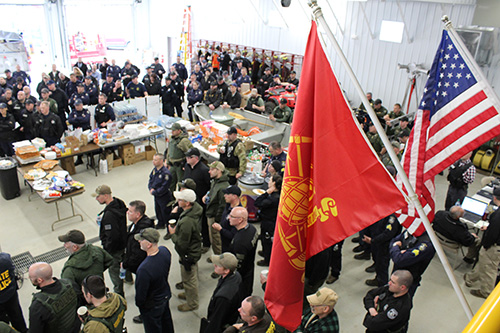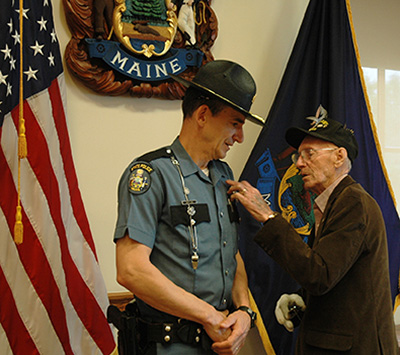Updated December 2018
- 1921
- 1922
- 1924
- 1925
- 1926
- 1927
- 1928
- 1931
- 1935
- 1936
- 1937
- 1938
- 1940
- 1941
- 1942
- 1943
- 1944
- 1945
- 1947
- 1948
- 1950
- 1951
- 1952
- 1954
- 1955
- 1956
- 1957
- 1958
- 1959
- 1960
- 1961
- 1964
- 1965
- 1966
- 1967
- 1968
- 1969
- 1970
- 1971
- 1972
- 1973
- 1974
- 1975
- 1976
- 1977
- 1979
- 1980
- 1981
- 1982
- 1983
- 1984
- 1985
- 1986
- 1987
- 1988
- 1989
- 1990
- 1991
- 1993
- 1994
- 1995
- 1996
- 1997
- 1998
- 1999
- 2000
- 2001
- 2002
- 2003
- 2004
- 2005
- 2006
- 2007
- 2009
- 2011
- 2012
- 2013
- 2014
- 2015
- 2016
- 2017
- 2018
-
1921
34 members of the State Highway Police begin work in July under the supervision of the State Highway Commission. 25 additional officers are commissioned in August. The officers, also known as Inspectors, mostly work on a seasonal basis, but a few work full-time. They enforce motor vehicle laws and collect money from auto registrations and driver license fees. Some are issued Harley-Davidson and Indian motorcycles but most are assigned to offices around the state.

-
1922
The State Highway Police are placed under the supervision of the Secretary of State.
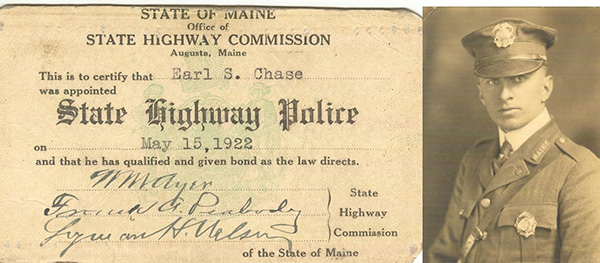
-
1924
State Highway Police Officer Emery Gooch of Waterville is killed in a motorcycle accident in Mattawamkeag on August 9. He had joined the force in July.
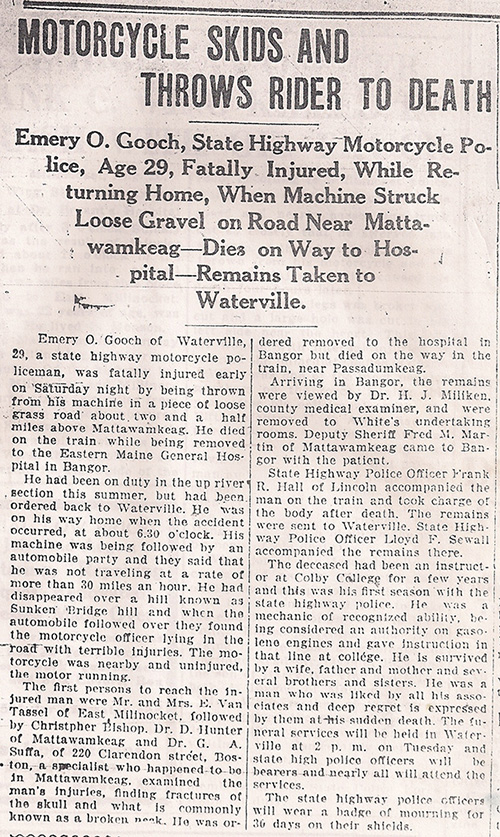
-
1925
"An act to enlarge the powers of the State Highway Police" is enacted into law by the Maine Legislature. The legislation allows the Governor to appoint a chief and sets the duties and powers of the new separate department.
Arthur H. Field, who had served as Lewiston Police Chief, is named the first Chief of the State Police and serves for two years.
On July 25, 1925, 60 members of the new department meet in Augusta with Governor Ralph Owen Brewster and Chief Field. They are commissioned as members of the State Highway Police, empowered to enforce all Maine laws, in addition to motor vehicle statutes. The new officers are assigned a motorcycle, pistol, and a law book and given patrol areas. The pay was $28 a week.
Trooper Fred Foster of Lisbon is killed on August 30 when his motorcycle strikes a horse, hauling a load of hay in Belfast. He was one of the new officers commissioned in July.

-
1926
The 1st Training Troop takes place at Camp Keyes in Augusta. William Hancock is the camp commander and the training took place from April 12 to May 28.
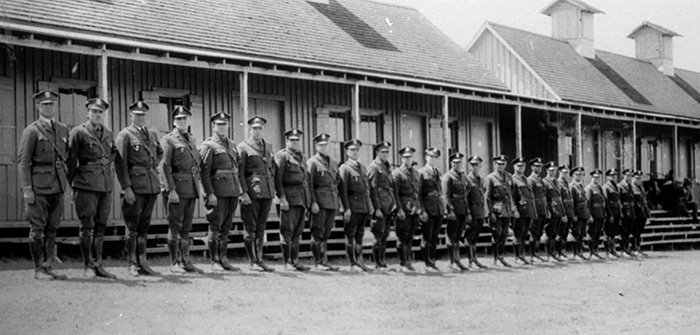
-
1927
State Adjutant General James W. Hanson is appointed Chief of the State Police by Governor Owen Brewster and serves for nine years.
The crime lab is formed after Trooper Leon Shepard is severely injured in a motorcycle accident and he learns criminology while he is recovering. Shepard oversees the lab until his retirement in 1946.

-
1928
Trooper Frank Wing is killed when his motorcycle collided with an oil truck in Millinocket on August 19. He had joined the State Police in June.
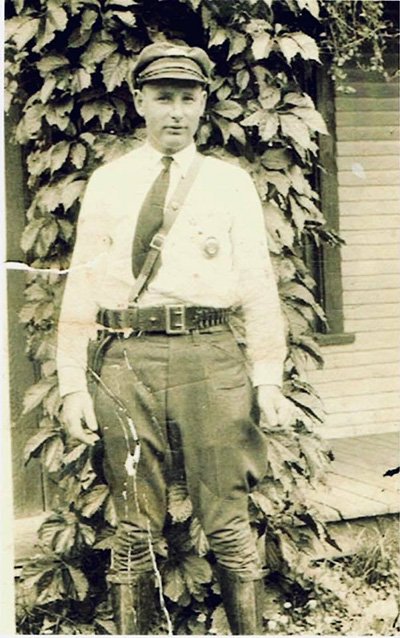
-
1931
The uniforms are changed from olive green to French blue with a black shoulder patch with red lettering and a green pine tree.


-
1935
"The State Highway Police are hereby designated and shall hereafter be known as the 'State Police'" is approved by the Maine Legislature. The name change makes official what had been customary for several years. Members are still required to re-enlist every three years.
The department expands to 100 troopers.
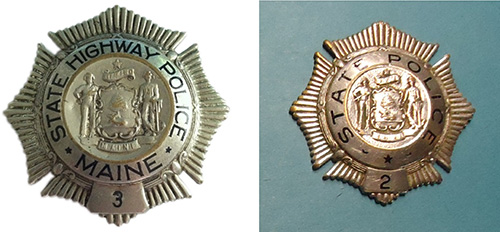
-
1936
The first automobiles are purchased. The 46 black sedans, costing $515 each, are traded for 47 Harley-Davidson motorcycles and 25 sidecars. Several motorcycles remain in use.
Captain Wilbur H. Towle is named Chief of the State Police by Governor Louis Brann and serves for two years.
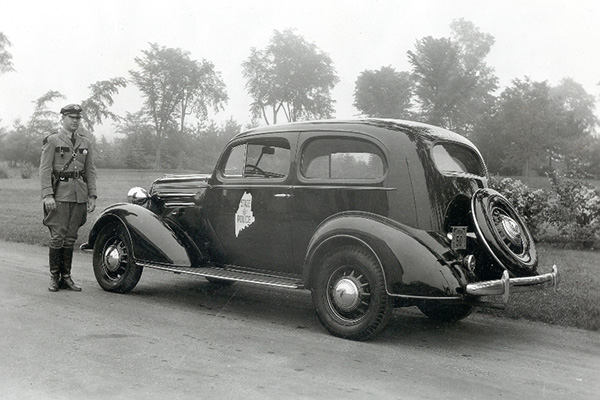
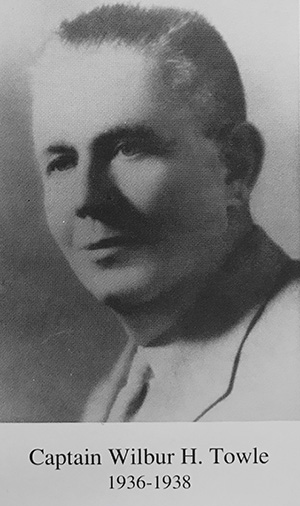
-
1937
The State Bureau of Identification is created by the Legislature under the control of the State Police. The Bureau will maintain all criminal records in the state.
Hundreds of striking shoe workers riot in Auburn. State troopers and the Maine National Guard are called out to restore order.

-
1938
General John W. Healy is named Chief of the State Police by Governor Lewis Barrows and serves for three years.
Barracks are constructed in Houlton along Route 1 to serve as the home for Troop F, which patrols Aroostook County. The building remains in use until 2000, when it is replaced by a new building constructed behind it.
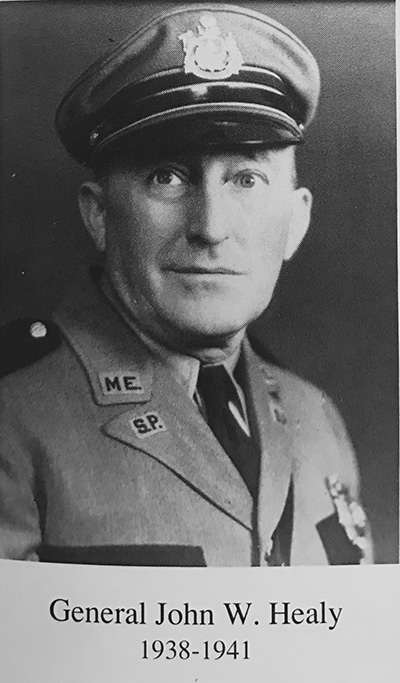
-
1940
New barracks are completed in Thomaston on Route 1 next to the Maine State Prison. The barracks is the home for Troop D and remains in use until 2010, when the troop's offices are moved to Augusta.
The first two-way radios are used and State Police radio stations are established in Thomaston, Wells and Augusta.
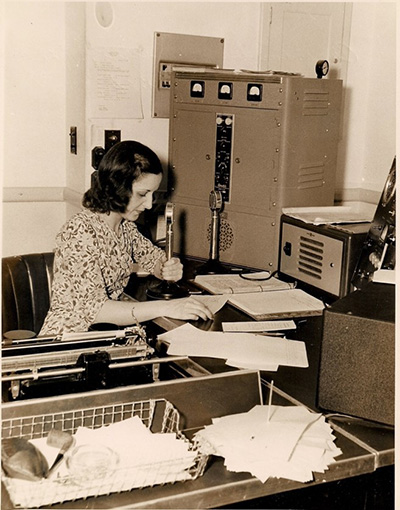
-
1941
State Police Headquarters at 36 Hospital Street in Augusta is completed and dedicated on October 2. Prior to that, various divisions of the State Police are in office space in Augusta, at the Adjutant General's building, State Highway Commission and at the Augusta Airport administrative building.
On December 7, Pearl Harbor is bombed by the Japanese and the United States enters World War II. By the war's end in 1945, 27 members of the State Police had joined the armed forces.
Henry P. Weaver is named Chief of the State Police by Governor Sumner Sewall and serves for two years, when he resigns to join the armed forces. He is seriously injured in a Jeep accident in Italy in 1943.
For the duration of the war, State Police enforce blackout restrictions and pleasure driving as gas rationing is in effect and other wartime security measures.


-
1942
State Police is divided into six troop areas:
- Troop A -- Wells
- Troop B -- West Scarborough
- Troop C -- Fairfield
- Troop D -- Thomaston
- Troop E -- Bangor
- Troop F -- Houlton
Work week for troopers is changed from a seven day week to one day off in seven.
-
1943
Captain Laurence C. Upton of Milbridge is named Chief of the State Police by Governor Sumner Sewall and serves for five years. He joined the State Police in 1926 and is the first chief to come up through the ranks.
Trooper Lewis Howard, now a Captain in the US Army Air Corps, is killed piloting a B-17 over southern France when it is shot down. Howard and his co-pilot are buried together at Arlington National Cemetery.
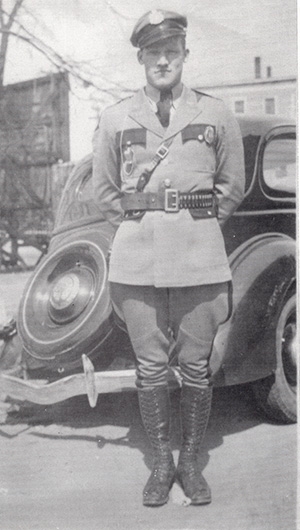
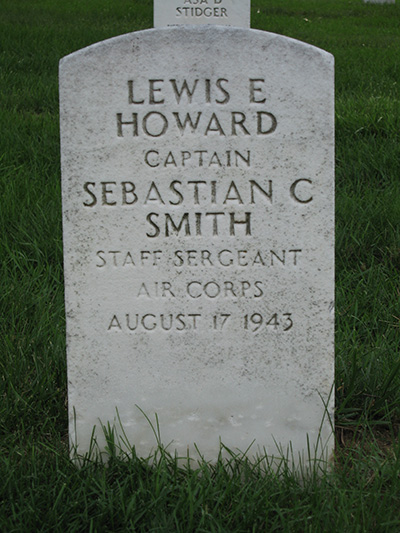
-
1944
Trooper Harold Ericksen of Portland, now a Lt. Colonel in the Army, in killed in action near St. Lo, France. Ericksen is buried in the American Cemetery at Normandy.
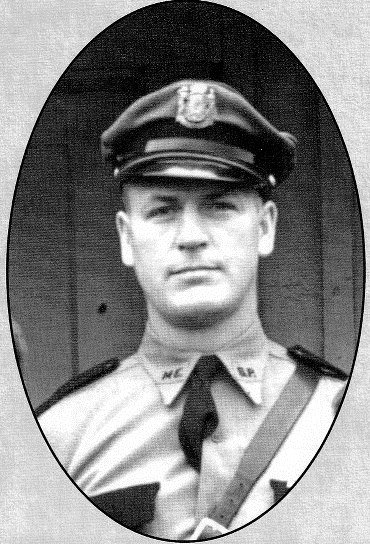

-
1945
The Maine Legislature passes a law requiring the chief of the State Police to come from the commissioned ranks of the department. Laurence Upton is reappointed as chief. His deputy chief is Captain Joseph Young.
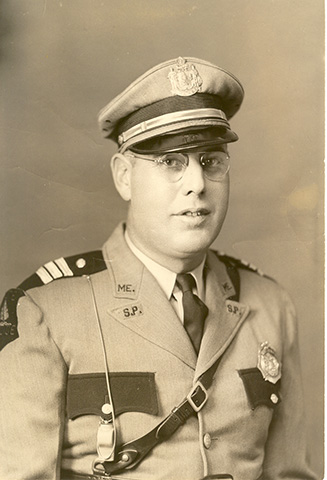
-
1947
The State Police radio system becomes a lifeline as troopers relay valuable information to firefighters battling the forest fires in late October that burned over 200,000 acres and killed 15 persons.
-
1948
New barracks in West Scarborough, along Route 1, are completed at a cost of $36,818. The new brick building is occupied by Troop B and remained in use until 1974.
Captain Francis J. McCabe of Augusta is named Chief of the State Police by Governor Horace Hildreth and serves for six years.
The 10th Training Troop takes place from April 26 to June 19.
-
1950
New barracks on Route 2 in Orono is completed and occupied by Troop E. The white Cape Cod building costs $48,000 and remains in use by State Police until 2013 when the troop moves to barracks in Bangor.
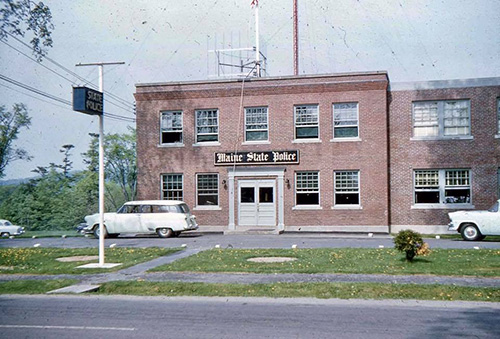
-
1951
The last ten State Police Harley Davidson motorcycles are sold at public auction.
-
1952
New barracks are completed on Route 2 in Skowhegan and occupied by Troop C. The building continues in use today.
A north side wing is added to Augusta Headquarters.
-
1954
Captain Robert Marx of Kennebunk is named Chief of the State Police by Governor Burton Cross. Marx serves as colonel for 12 years, the longest tenure of any chief.
Reorganization of the department is approved by the Governor and Executive Council, providing for a central staff of seven; a chief, deputy chief and five captains.
Liaison is established between the State Police and the Civil Defense Agency.
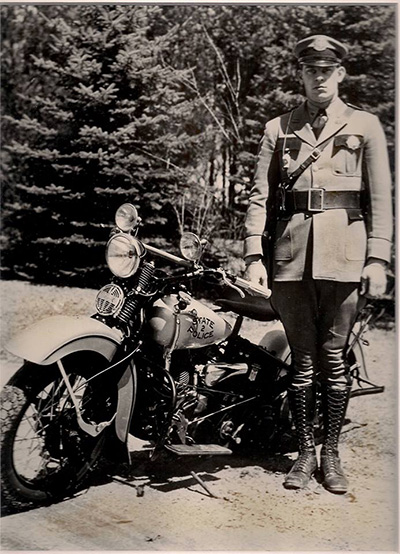

-
1955
Troop G is established to patrol the Maine Turnpike which is extended from Portland to Augusta during the year.
Troop detectives were selected for each troop. The first detective named is Otis Labree for Troop F in Houlton.
New barracks and a weigh station in Kittery are completed along Route 1 and occupied by Troop A.
New Stetson style hat replaces the cap used since the 1920s. The black shoulder patch is replaced by the one similar to the one in use today.
Department adopts new license plates with red letters on white background and words "State Police", replacing former plates with black numerals on a blue background with initials "S.P.".
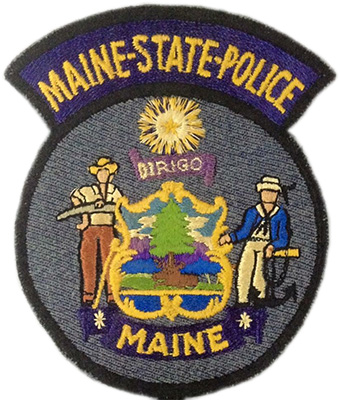
-
1956
Revolving blue roof lights are installed for the first time on cruisers.
A polygraph room is equipped and put into use at Augusta Headquarters.
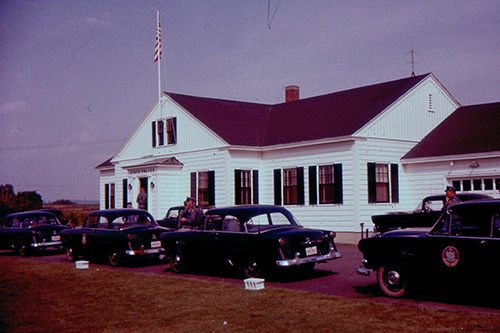
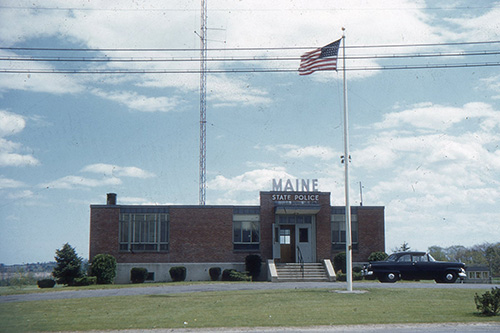
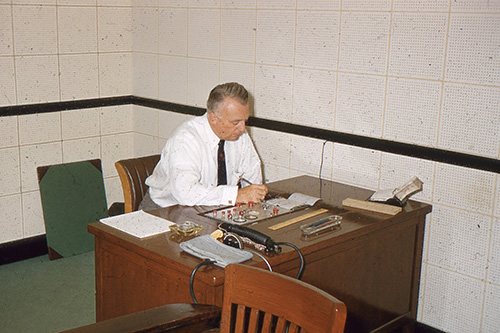
-
1957
Following a threat on the life of Governor Edmund Muskie, Troopers are assigned to an Executive Protection Unit to give round the clock protection to governors. Detective Millard Nickerson is the first to be appointed to EPU.
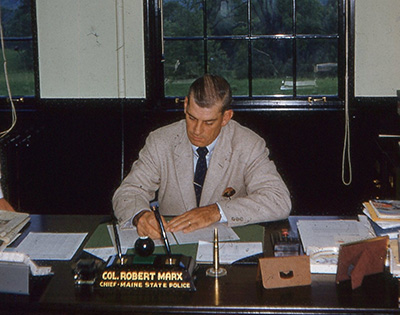
-
1958
Seven people are killed when their car is struck by a tractor-trailer on Route 201 in Richmond during Labor Day weekend. The crash is investigated by troopers and is the deadliest in Maine history, up to that time.
New garage completed in the rear parking lot of Augusta Headquarters to maintain the State Police fleet. The garage remained in use as a repair facility until 1992, when it moved elsewhere in Augusta.
Two bloodhounds are acquired by the department and become the first dogs of the canine unit. Trooper William Bickford of Norway is the first handler.
-
1959
A Limerick man, upset over finances, shoots and kills his wife, the Westbrook Police Chief, and wounds two state troopers, Willard Parker and Stephen Regina. The gunman kills himself after hundreds of shots were fired in the five hour gun battle between him and police. Over 100 police officers responded to the shooting at the man's Limerick home.
-
1960
The 20th Training Troop takes place at Camp Keyes in Augusta from Sept. 5 to Nov. 11. Captain Willard Orcutt serves as academy commander.

-
1961
An open collar short-sleeved shirt is adopted for summer wear.
The Traffic Division is reorganized to include traffic records and the motor vehicle inspection program.
-
1964
Trooper Charles Black of York is shot to death on July 9 while responding to a bank robbery in South Berwick. He is the first trooper killed by gunfire and the fourth to die in the line of duty. Black joined the State Police in 1958.
In Trooper Black’s honor, State Police establish the Trooper of the Year award. Trooper Herman Boudreau of Brunswick is the first recipient.
-
1965
A second wing is added to Augusta Headquarters, on the south side of the buidling.
The color of cruisers is changed from black to blue, and the license plates are changed to blue with white lettering. Both color schemes remain in use today.
-
1966
Deputy Chief Parker F. Hennessey of Augusta is appointed Chief by Governor John Reed and serves for eight years. He dies of a heart attack in his office in 1974.
-
1967
Perleston “Bub” Pert is named the first public information officer for State Police.
-
1968
Criminal Intelligence Unit is formed to investigate white collar and organized crime.
-
1969
Troopers work week is changed from a six-day week to six days on and two days off.
-
1970
276 people lose their lives on Maine highways, the most fatalities ever in one year. Troopers investigate most of those traffic crashes.
Cruisers are changed to four door sedans, replacing the two door models used for decades.

-
1971
70 troopers are dispatched to Madawaska to maintain order during a labor strike at the Fraser Paper Company. A confrontation between troopers and over 300 strikers and family members resulted in rocks being thrown and six State Police cruisers damaged.
The Maine State Troopers Association is formed to represent troopers and sergeants on labor related issues.
-
1972
The Maine Department of Public Safety is created by the Legislature and the State Police becomes a Bureau within that new department. State Police Colonel Parker Hennessey is named the first commissioner and continues to also serve as chief of the State Police.
50 Troopers are joined by 150 other law enforcement officers from across New England in a gambling raid at the Poland Spring Inn. 60 persons are arrested, making it the largest mass arrest in Maine.
-
1973
Corporal rank is instituted and sixty troopers and detectives are promoted to the new rank.
The 29th training troop is the first to graduate from the new Maine Criminal Justice Academy in Waterville. The campus of the former Thomas College served as the state's police training facility until 2001.
-
1974
Deputy Chief Donald E. Nichols Sr. of Augusta is appointed Chief of the State Police by Governor Kenneth Curtis and serves for two years.
Troop I is established to patrol Interstate 95 from Waterville to Houlton. The Troop was disbanded in 1984 and patrol of I-95 is assumed by Troops C & E.
Troop A (formerly Kittery), Troop B (formerly West Scarborough), Troop G (turnpike) and the Southern Criminal Investigation Division are relocated into a rented office building on Route 1 in Scarborough, under a 15 year lease.
The Uniform Crime Reporting Division is established to collect and evaluate crime reports from all Maine law enforcement agencies.
The high collar dress blouse is adopted for formal occasions.
-
1975
Major J. Edward Marks retires from the State Police after a 50-year career. Marks was one of the original troopers hired in 1925.
State Police acquire its first plane to enforce the 55 mph speed limit imposed during the nationwide energy crisis. Trooper Brad Cochran from Troop A is selected as the first pilot.
-
1976
Deputy Chief Allan H. Weeks Jr., is appointed Chief of the State Police by Governor James Longley and serves for eleven years. Albert Jamison and John Clark serve as his deputy chiefs.
The Tactical Team is created, made up of specially trained troopers, to respond to barricaded person and hostage-type emergencies. The team's first call is in Greenwood when a gunman opened fire on two troopers during a disturbance call. After an all-night standoff, the man is arrested by the team.
The patrol force is equipped with citizen band radios, purchased with a federal grant. Because of CB's wide popularity with motorists the new radios are used as a communications resource for highway safety.
An Underwater Recovery Unit, known as the Dive Team, is established to assist in criminal investigations.
A confiscated motorhome seized in a drug investigation is converted into a "mobile command post" to be used at major crime scenes.
-
1977
Anna Polvinen of West Paris becomes the first woman trooper following her graduation from the Maine State Police Academy, as a member of the 34th Training Troop. She retires as a detective in 2006.
The .38 caliber service revolver is replaced by the more powerful Smith & Wesson .357 magnum.
The age limit for applying for a trooper is lowered to 20. However the applicant must be 21 upon graduation from the academy.
The Accident Reconstruction program is organized with Trooper Gary Phillips as its first member and he oversees the unit until 1990 when he retires.

-
1979
17 people are killed when a Downeast Airlines plane crashes in rain and fog at the Owl's Head Airport. State Police are among the many agencies that rush to the scene to assist.
-
1980
Trooper Thomas Merry of Smithfield is struck and killed by a car involved in a high speed chase in Palmyra while attempting to set up a roadblock. He is the fifth trooper to die in the line of duty. Merry joined the State Police in 1977.
Beginning in April, 90 troopers spend several weeks at the Maine State Prison when intelligence indicates the possibility of an inmate uprising. The "lock down" is the largest assignment of troopers over an extended period.
The canine unit is formed after two troopers and their dogs receive out-of-state training.
A BAT-mobile is put into use. BAT, short for breath alcohol testing, is a specially equipped van to test rural drunk driving offenders.
-
1981
George H.W. Bush is sworn in as Vice President of the United States. State Police become involved in the security at his ocean front home in Kennebunkport. Troopers continue to assist the Secret Service after Bush is elected President in 1988 and when he leaves office.
Two escaped convicts from the Maine State Prison begin a 22-day manhunt. The search was concentrated around Moody Mountain in Searsmont and hundreds of troopers, deputy sheriffs, game wardens and 20 canine teams from across New England are involved in the search. The escapees are captured on August 5.
State Police canine "Ben" was wounded by one of the escapees early in the search and later returned to duty.
-
1982
Troop J is established to serve Washington and Hancock counties. The barracks is a converted library on Route 191 in East Machias and is used until 2005 when the barracks is relocated to Ellsworth in a rented office building.
The State Police Canine School conducts its first graduation of four troopers and their dogs.
-
1983
The National Governor's Conference, attended by 47 governors, is held in Portland and 150 troopers provide security for the weeklong event.
Maine State Police Memorial Scholarship Fund is established to provide scholarships to the children of active, retired or deceased State Police officers. Henry Ferne of Wiscasset is the benefactor.
-
1984
OUI roadblocks are initiated by State Police in rural areas to apprehend drunk drivers.
The Organized Crime Investigative Division is established to coordinate criminal intelligence and drug enforcement.
The Division of Internal Affairs is established to investigate complaints against troopers.
State Police coordinate the first marijuana eradication program, aimed at locating outdoor plots of marijuana.
Child abuse investigators are assigned to the Criminal Investigation Division.
The hostage negotiation team is established.
-
1985
Retirement benefits for troopers are changed. For new troopers, full retirement benefits will start after 25 years of service at the age of 55. Veteran troopers remain under the 20-year retirement plan.
The first State Police awards night is held to honor employees, retirees and civilians.
State Police institute the motto, "Semper Aequus" (Always Just).
-
1986
State Police Crime Laboratory is constructed next to headquarters in Augusta. The 12,000 square foot building contains lab space for serology, finger printing, firearms examinations and photography.
Trooper Michael Veilleux of Augusta is killed when he loses control of his cruiser and it crashes in Dayton. He is the sixth trooper to die in the line of duty. Veilleux graduated from the State Police academy a month earlier.
Troop G relocates its headquarters to Crosby Farm, along the Maine Turnpike in South Portland.
-
1987
Captain Andrew E. Demers, Jr. is named Chief of the State Police, by Public Safety Commissioner John R. Atwood and Governor John R. McKernan and serves six years. Daniel Cote and Alfred Skolfield serve as his deputy chiefs.
60 troopers keep the peace during a vocal and tense labor strike at the International Paper Co. in Jay.
-
1988
Beretta 9 mm semiautomatic pistols are issued to troopers to replace the .357 Smith & Wesson service revolvers.
Maine voters approve a $3 million public safety bond issue. The projects proposed for improvement are new State Police barracks in Gray and Alfred, a South Portland garage and renovations to the Thomaston and Orono barracks.
-
1989
Detective Giles Landry of Lewiston is shot and killed investigating a child abuse case in the town of Leeds on March 31. He is the seventh trooper to die in the line of duty. Landry joined the State Police in 1976.
Construction is completed at the new barracks in Gray, along Route 26. The facility houses Troop B, the southern communications center and the criminal division. The project costs $1 million.
-
1990
Lt. Rene Goupil dies of a heart attack during physical training in Waterville. He was commander of the State Police Academy and joined the State Police in 1970.
New barracks is completed in Alfred, along Route 202, to house Troop A. The building, costing $450,000, is funded from proceeds of the 1988 bond issue.
The new fleet maintenance facility along the Maine Turnpike in South Portland is completed at a cost of $688,000.
The former Scarborough barracks on Route 1 is vacated following a 15 year lease.
Utilizing a $90,000 federal grant, a new "Mobile Command Post" is purchased. The 36 foot long motor home, containing investigative and communications equipment, will be used at major crime scenes.
Retired Lt. Foster King of Rangeley, dies at the age of 86. He was the last surviving member of the original troopers hired in 1925.
62 troopers are called into downtown Waterville after several hundred persons become disruptive at a July 4th celebration.
-
1991
The Maine Law Enforcement Officer's Memorial in Augusta is dedicated and honors all Maine law enforcement officers killed in the line of duty. As of December 2018 there are 84 names on the memorial.
70 troopers and 140 other local and county law enforcement officers oversee a large and vocal AIDS demonstration in Kennebunkport, near President Bush's summer home. There are no arrests but it is the largest number of demonstrators in recent times in Maine.
-
1993
Deputy Chief Alfred R. Skolfield is appointed chief by Public Safety Commissioner John Atwood and Governor John McKernan. He serves for four years and names Malcolm Dow as his deputy chief.
-
1994
Trooper Jeffrey Parola of Dexter is killed when his cruiser crashes in Sidney on November 13. Parola, a member of the Tactical Team, was responding to a domestic violence call. He is the eighth trooper to die in the line of duty. Parola joined the State Police in 1989.
The bomb disposal team is formed after the military disbands its unit at the Brunswick Naval Air Station. Two troopers receive special training and two more are added to the team in 1996.
To help curb high speed police chases, 550 spike mats are purchased by the Bureau of Highway Safety and distributed to State Police, county and local law enforcement agencies.
-
1995
Video cameras are purchased with federal highway safety funds and installed in many cruisers. The cameras prove useful in drunk driving enforcement and have several other law enforcement uses.
-
1996
Trooper James Griffith of Thomaston is killed when his cruiser is struck by another vehicle on Route l in Warren. He is the tenth trooper to die in the line of duty. Griffith joined the State Police in 1986.
-
1997
Deputy Chief Malcolm T. Dow of Houlton is appointed chief by Governor Angus S. King and serves for two years. David Viles serves as his deputy chief.
Detective Glenn Strange of Hodgdon dies of heart problems days after arresting a violent drunk driver in Linneus. He is the eleventh trooper to die in the line of duty. Strange joined the State Police in 1994 following a teaching career.
A $300,000 addition to the State Police crime lab in Augusta is opened to house a DNA section.
60,000 fans of the rock group "Phish" attend a three day rock concert at the former Loring Air Force Base in Limestone. State Police coordinate the security for the largest rock concert ever staged in Maine. The event is repeated there in 1998 and 2003.
Maine troopers and detectives respond to New Hampshire after the two NH troopers, a judge, and a newspaper editor in Colebrook are shot to death. The gunman flees to Vermont and is killed in a gun battle with police.
-
1998
The bridge on Route 1 in Warren is dedicated to Trooper James Griffith, and a new bridge on Route 2 in Palmyra is dedicated to Trooper Thomas Merry. Both troopers were killed in car crashes.
-
1999
Lt. Michael R. Sperry of Stratton is appointed the 15th chief of the State Police by Public Safety Commissioner Michael F. Kelly and Governor Angus S. King. Sperry serves for five years. Serving as his deputy chief is Jeffery Harmon.
225 troopers are called out for New Year's Eve (12/31/99) in case of widespread computer problems associated with the new millennium. The troopers were stationed at armories around Maine and no problems took place.
H&K 45 caliber handguns are issued to troopers, replacing the Beretta 9mm used since 1988.
-
2000
The crime lab becomes nationally accredited following four years of work on the accreditation process.
The new Public Safety building in Houlton is opened to replace the old Houlton barracks. The $1.8 million dollar building is located along Route 1, behind where the former barracks stood since 1938.
The 47th State Police Training Troop graduates 22 new troopers following 20 weeks of training at the academy in Waterville. Beginning in 2001, troopers will be trained with municipal and county officers at the new Maine Criminal Justice Academy located at the former Oak Grove Coburn School in Vassalboro.
"Integrity, Compassion, Fairness, Excellence" are adopted as the core values of the State Police.
The Computer Crimes Unit is organized with State, Lewiston and Brunswick Police to investigate computer crimes, primarily child pornography. Initially housed at Lewiston Police Department, the unit relocated to the Maine Criminal Justice Academy in 2004.
-
2001
On September 11, State Police took only 45 minutes to set up their own command post at the crime lab to monitor and coordinate their response during the day. Two of the terrorists flew out of the Portland Jetport that morning and their rented car was located in the Jetport parking garage that night. The car was impounded by State Police and taken to the crime lab for processing. In the weeks that followed, State Police received hundreds of tips about suspicious activity and those calls were coordinated with the FBI, although most of the calls were of little use.
-
2002
14 migrant woods workers were killed when the van they were in plunged off the John's Bridge into the Allagash Wilderness Waterway on September 12. There was one survivor. It was the worst motor vehicle crash in Maine history and troopers responded to the remote location to investigate.
-
2003
One person died and 15 others were sickened drinking coffee poisoned with arsenic at the Gustav Adolph Lutheran Church in New Sweden. Five days later Daniel Bondeson of New Sweden, a parishioner, shoots and kills himself and leaves a note taking responsibility. The case was investigated by State Police and attracted worldwide media attention.
-
2004
Major Craig A. Poulin is appointed Chief of the State Police by Commissioner Michael P. Cantara and Governor John E. Baldacci. Poulin serves as colonel for two years and John Dyer serves as his deputy chief.
State Police headquarters moves from 36 Hospital Street to 45 Commerce Drive in Augusta, joining several other bureaus of the Maine Department of Public Safety in one location. The Hospital Street building, which served as headquarters since 1941, continues to be used by the criminal and traffic divisions.
Maine's Sex Offender Registry, in effect since 1993, goes on-line and averages 200,000 computer hits a month. The State Bureau of Identification, a division of State Police, maintains the registry.
Three women and four children are killed when their speeding SUV crashes into trees along Interstate 95 in Carmel on May 9. Troopers investigate the crash, which is the worst fatality on Maine's interstate system.
The Democratic National Convention is held in Boston and 29 Maine troopers are assigned to assist Massachusetts State Police with security.
-
2005
The Augusta Regional Communications Center moves from the former State Police headquarters on Hospital Street to 45 Commerce Drive and is renamed – Central Maine Regional Communications Center.
-
2006
The Maine Information & Analysis Center is set up within State Police to share intelligence and criminal information with other states and federal counterparts. It is an outgrowth of the 9/11 terrorist attacks.
-
2007
Lt. Patrick Fleming of Fairfield is appointed chief by Governor John Baldacci and serves for four years. Robert Williams is named deputy chief.
The Incident Management Assistance Team is established to manage large incidents and pre-planned events. A 2005 Freightliner command post is purchased to provide communication resources for the team.
-
2009
The Troop G offices are relocated to the new Maine Turnpike building, off exit 46 in Portland. Troop G had been headquartered at the Crosby Farm on the turnpike since 1986.
-
2011
Deputy Chief Robert Williams is appointed chief by Public Safety Commissioner John Morris and Governor Paul LePage. He serves as Colonel until the fall of 2018. Raymond Bessette is selected as deputy chief and he is later succeeded by John Cote.
On December 17, 22-month-old Ayla Reynolds is reported missing from her Waterville home. The child's disappearance begins the largest criminal investigation in State Police history.
-
2012
13 Troopers travel to New Jersey and New York to assist those two states with law enforcement duties in the aftermath of super-storm Sandy
-
2013
Troop E moves to barracks to Bangor after being located in Orono since 1952.
State Police begin to purchase all wheel drive SUVs to replace passenger cars as regular patrol cruisers.
-
2014
The regional communications center at the Orono barracks is also moved to the Bangor location.
All members of the State Police are issued .223 caliber patrol rifles.
-
2015
Troopers conduct a 68-day manhunt for murder suspect Robert Burton, who shot and killed his girlfriend, in Parkman. Burton hid in woods around Parkman and eventually turned himself in. It was the longest manhunt in State Police history.
Troopers investigate a 142-vehicle pileup on snowy Interstate 95 in Carmel in February. 26 persons were injured but there were no deaths in the largest crash in state history.
-
2016
The Unsolved Homicide Unit is established with two detectives and a forensic chemist working full time with the Attorney General's Office. As of December 2018, Maine had 76 unsolved homicides and 28 missing person cases the unit was handling.
Eight Troopers travel to help provide security for the Republican National Convention in Cleveland. They are joined by 1500 other Troopers from around the country.
State Police form a new crowd management team to respond to disturbances, large demonstrations and riots.
-
2017
Three unmanned aerial vehicles (drones) are acquired to help document and photo crash and crime scenes.
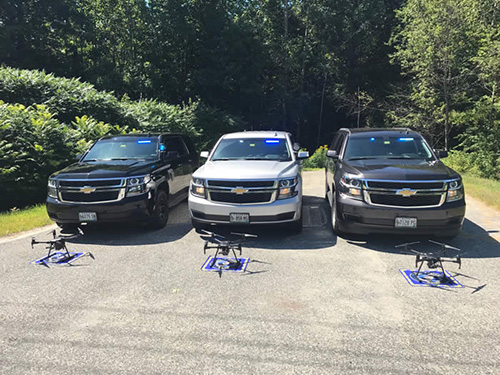
-
2018
State Police and the Somerset Sheriff's Office coordinate the four-day manhunt for the killer of Somerset Deputy Eugene Cole, who is shot to death in Norridgewock. The manhunt also includes hundreds of other law enforcement officers.
Six Harley Davidson Electra-Glide motorcycles are purchased and a ceremonial motorcycle unit is formed for parade and special events. Motorcycles were part of the State Police fleet from 1921 to 1951.
John Cote is appointed chief of the State Police by Commissioner John Morris and Governor Paul LePage. William Harwood is named deputy chief.
